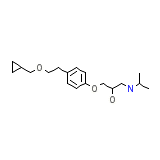Kerlone




Kerlone Brand names, Kerlone Analogs
Kerlone Brand Names Mixture
- No information avaliable
Kerlone Chemical_Formula
Kerlone RX_link
Kerlone fda sheet
Kerlone msds (material safety sheet)
Kerlone Synthesis Reference
Kerlone Molecular Weight
Kerlone Melting Point
Kerlone H2O Solubility
Kerlone State
Kerlone LogP
Kerlone Dosage Forms
Kerlone Indication
Kerlone Pharmacology
Kerlone Absorption
Kerlone side effects and Toxicity
Kerlone Patient Information
Patients, especially those with evidence of coronary artery insufficiency, should be warned against interruption or discontinuation of Kerlone therapy without the physician's advice.
Although cardiac failure rarely occurs in appropriately selected patients, patients being treated with beta-adrenergic blocking agents should be advised to consult a physician at the first sign or symptom of failure.
Patients should know how they react to this medicine before they operate automobiles and machinery or engage in other tasks requiring alertness. Patients should contact their physician if any difficulty in breathing occurs, and before surgery of any type. Patients should inform their physicians or dentists that they are taking Kerlone. Patients with diabetes should be warned that beta-blockers may mask tachycardia occurring with hypoglycemia.
How to Use This Medicine:
Tablet
- Your doctor will tell you how much of this medicine to take and how often. Do not take more medicine or take it more often than your doctor tells you to.
- You may take this medicine with or without food.
If a dose is missed:
- If you miss a dose or forget to use your medicine, use it as soon as you can. If your next regular dose is less than 8 hours away, wait until then to use the medicine and skip the missed dose.
- Do not use extra medicine to make up for a missed dose.
How to Store and Dispose of This Medicine:
- Store the medicine at room temperature, away from heat, moisture, and direct light.
- Keep all medicine out of the reach of children and never share your medicine with anyone.














